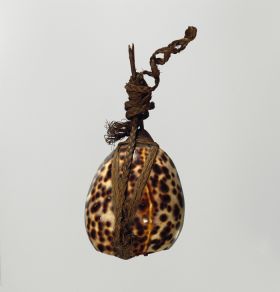Lure maka feke
Place: Tonga
Category: Fishing & hunting
stalactite, cowrie shell, wood, coconut fibre, Tonga, l. 22.5 cm, Inv. Oz 219
Humphrey No. 282: ‘another [bait or Decoy] made of part of a large brown Stalactitical Spar, and the back of a large leopard Cowry Shell, the Tail is of a Twig. From the Friendly Isles.’
The lure consists of a brownish, cone-shaped piece of dripstone (stalacite), securely fastened to a curved dish of a tiger cowry shell. A stick of wood is attached to that part of the stalactite that is not covered by the shell. Part of the fishing line is knotted several times at its end. The cord for attaching the wooden stick is made out of coconut fibres braided from the niu (Cocos nucifera), as is the fishing line. The lures were used for catching octopus. ‘One sailed with the boat past the coral reef caves, where the octopus waited for their prey, let the lures hang overboard and tugged at the line. The octopus sucked firmly on to the presumed prey, and were then pulled up into the boat’ (Moschner 1955: 191).
Labillardière illustrated a similar lure (1800: Atlas, PI. 32, Fig. 25). Kaeppler (1978a: 234) mentioned comparable pieces in the collections of Vienna, Dublin, Oxford, and Wörlitz. Inken Köhler, Ulrike Rehr, Gundolf Krüger
Sources
Kaeppler, Adrienne L, ‘Artificial Curiosities’ Being An Exposition of Native Manufactures Collected on the Three Pacific Voyages of Captain James Cook RN [Exhibition catalogue], Bishop Museum Press, Honolulu, 1978a.
Labillardière, Relation du voyage à recherché de la Pérouse, vol. 2, Paris, 1800.
Moschner, Irmgard, ‘Die Wiener Cook-Sammlung, Südsee-Teil’, Archiv für Völkerkunde, Vienna and Stuttgart, 1955, vol. 10, pp. 136-253.

